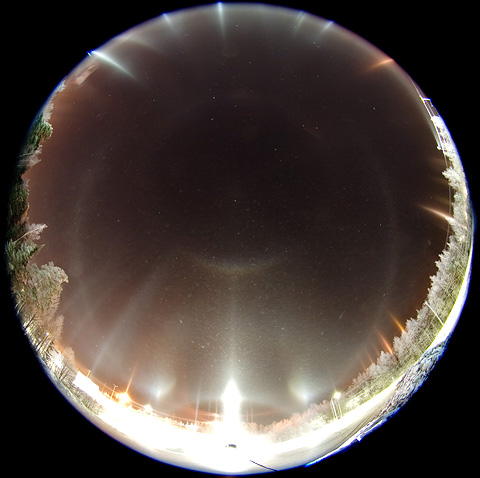
Superparhelia are also seen in the main image. Furthermore, there appears to be a faint, illuminated spot right in the zenith (first observed by Marko Mikkilä) in many images. This phenomenon is unaccounted for.
The subparhelia ( 2 ) appear to exhibit some type of lowitz forms, but this could also be due to divergent light effects. The subhorizontal helic arc is also a bit of a mystery as other parry forms seem to be missing. The lamp was at a negative elevation of ca. 11 degrees.
Other images are also available online ( 3 ).
Jari, congratulations! Great displays!
ReplyDeleteHave you tried simulating? I would bet there is Parry overlapping and overexposed with subsun, so from that part there should be no problem. Possibly missing of Hastings arc proves tricky in simulations.
ReplyDeleteI was there together with Jari, just watching and enjoying, which was a new kind of experience.
Jakub, thanks!
ReplyDeleteMarko, thanks for the commments. You're probably right and there were a population of Parry oriented crystals.
I must try and simulate it with care.
Well, it may turn out to be difficult. Just realized that the camera is pointing so low that you may have to deal with missing of 46 Parry's as well...
ReplyDeleteThat spot in the zenith, I think Mikkilä first "described" it. We saw it in Kilpisjärvi for a short while when there was a column/Parry stage in the display.
Absolutely, Mikkilä has mentioned this spot in the zenith before. Was it not in the blog? My memory probably fails me on this one. I think he has also seen another effect in there as well, observed from very close to the lamp.
ReplyDeleteAs to the simulation, yep, it could be challenging. Must try it later.
Once again you have amazing stuff here. Congrats Jari and Marko!
ReplyDeleteI remember that spot in the zenith in Kilpisjärvi. That was the time when the Kern arc was photographed and the lamp suddenly failed us. It did not come out in that Kern photo, and later the spot did not return.
I saw that zenith spot on both good diamond dust nights this year (1-2. and 2-3.1.). I did not pay attention to it because at the time it showed up I was rather busy with the other halos. I was only able to see it close to the lamp or when I pointed the lamp heavily upwards (40° or so).
ReplyDeleteIt is my impression as well that this spot has mainly been observed close to the lamp or when pointing the lamp steeply upwards.
ReplyDeleteGotta echo the same comments about this wonderful display. That heliac arc could be from lowitz orientation because lowitz orientated plates will produce heliac arc as well. I can't wait to do these halos when I got my 3,000,000 candle power spot light with 12v adapter for 120v outlet and don't forget the paint gun I bought as well. Just keep up the good work Jari and GIT R DONE:)!
ReplyDeleteThanks Michael! Jukka Ruoskanen has explored in depth the Lowitz orientation and helic arc. He should be able to comment on this in detail.
ReplyDeleteI hope you get many great displays with your setup. It is great fun!
I was unable to open the video but judging by the other halos it is possible that the zenith spot has been visible at times.
ReplyDeleteWalter Tape has explained this halo, which is actually the supersun. The link takes you to my previous images.
Congrats to Marko "the Kern" Mikkilä, who first turned our attention to this spot!